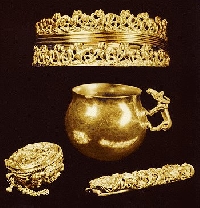Where does gold come from?
By Catalogs Editorial Staff

As one of the three precious metals, gold is treasured for its rarity, its malleability, and its beautiful appearance. Gold was used by artisans to produce jewelry as early as six thousand years ago, and is still prized for its permanence and ability to glorify human skin tones.
Additionally, gold has uses as a monetary standard, an easily workable dental material, and in the modern world, as a highly versatile and reliable material in the development of new technologies.
So what exactly is gold, and where does it come from?
In the simplest terms, gold is a naturally occurring chemical element. It is represented by the symbol Au (from the Latin Aurum, for ?shining dawn?), and has an atomic number of 79. Gold is thought by scientists to have initially occurred as the result of neutron star collisions (think of these as remarkably dense stars, with for instance the mass of our own sun, but a total diameter of less than 15 miles). As the ashes of these neutron-rich explosions scattered, heavy, neutron-rich elements such as gold were formed.
Gold is traditionally found in nuggets and grains, which have loosened from the ore that once contained it. These gold deposits, referred to as alluvial or placer gold, are often found in streambeds, where it has collected and fused into nuggets. Through history, many gold rushes have occurred following the discovery of placer gold in areas that were once active streambeds.
~
Today, much of the world?s gold is produced by deep-mining. This is a big business, and involves the use of drills, dynamite, and other technologies to dig deep into gold-rich mines, where gold is then found and hoisted out by miners.
In some cases, chemical processes are used to extract the gold from other rocks. In one such process, called cyanidation, rocks proven to contain gold are mixed with a sodium cyanide solution, which will leach out any gold as a gold cyanide solution. Zinc is then added to sludge out any desirable gold and silver particles, and the zinc is then removed using sulfuric acid, leaving only the valuable metals.
The single greatest source of the world?s gold over the last century has been South Africa. South Africa has accounted for almost 50% of the world?s gold, or about 80,000 of the 160,000 or so tons of gold that have ever been mined. In most years only about 2-3,000 tons of gold are mined in the world. Recently, deep-mining in South Africa has slowed, and China is now the world?s leading producer of gold. The United States, Russia, Australia, and Peru are also all major producers of gold.
Of course, much of the gold we have today is simply recycled. As a truly renewable resource, and one which is too valuable to be discarded, our current gold supply is made up of recycled gold jewelry, coins, bullion, treasure, and all of the gold found and mined over the last centuries.
References:
Gold Price
Web Elements: Gold
Popular Savings Offers











